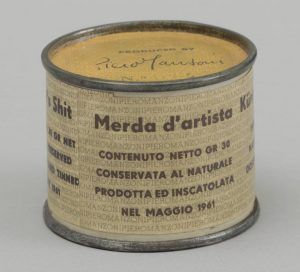Paul Bloom in The New Yorker:
 In 1961, Piero Manzoni created his most famous art work—ninety small, sealed tins, titled “Artist’s Shit.” Its creation was said to be prompted by Manzoni’s father, who owned a canning factory, telling his son, “Your work is shit.” Manzoni intended “Artist’s Shit” in part as a commentary on consumerism and the obsession we have with artists. As Manzoni put it, “If collectors really want something intimate, really personal to the artist, there’s the artist’s own shit.”
In 1961, Piero Manzoni created his most famous art work—ninety small, sealed tins, titled “Artist’s Shit.” Its creation was said to be prompted by Manzoni’s father, who owned a canning factory, telling his son, “Your work is shit.” Manzoni intended “Artist’s Shit” in part as a commentary on consumerism and the obsession we have with artists. As Manzoni put it, “If collectors really want something intimate, really personal to the artist, there’s the artist’s own shit.”
Manzoni originally priced the tins according to their equivalent weight in gold, but they were purchased by the Tate Gallery and other collectors for much more, and, in 2016, one of the tins was bought in Milan for two hundred and seventy-five thousand euros. Plainly, then, some like this work; they believe that it’s of value. Others see it as ridiculous. In “The Art Instinct,” the philosopher Denis Dutton takes considerable pleasure in telling the story of how Manzoni failed to properly autoclave the tins, and many of them, years later, in private collections and museums, exploded.
You’d think that psychologists would have a lot to say about our differing reactions to such creations, but research in art and aesthetics tends to focus on more conventional forms of art. There are a lot of studies on the perception of tonal music, exploring which aspects of musical pleasure are universal and which vary across culture, what babies and children prefer to listen to, how expertise shapes our perception of music, and so on. There is research into figurative art, usually paintings, much of it exploring how we make the leap from a two-dimensional array of colors and shapes to a three-dimensional world. But there’s little research on our reception of work such as “Artist’s Shit,” or the better-known pieces by artists such as Marcel Duchamp, Andy Warhol, Jackson Pollock, and Mark Rothko.
More here.
